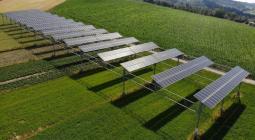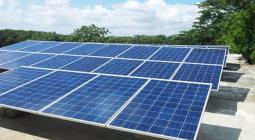The Renewable Energy Revolution Is Over (Now It’s A Mop-Up Operation).

If you blinked, you missed it. An obscure energy company based in Denver has just figured out how to provide rural electricity ratepayers with what they desire: renewable energy at low prices that beat the stuffing out of ancient coal power plants. If all goes according to plan, the maneuver could lay the groundwork for retiring both coal and gas power plants at a more rapid clip.
The Importance Of Being Rural
The power of rural ratepayers is a force to be reckoned with. Thanks to a rural electrification policy that dates back to the original New Deal of the 1930s, much of the US land mass gets its electricity through the not-for-profit, customer-owned rural electric cooperative system instead of for-profit power companies.
Socialism!
As of 2017, almost 900 electric co-ops covered 42 million people in the US, accounting for about 56% of the overall land mass. Co-ops serve ratepayers in all but three US states. They also claim territory in 2,500 of the nation’s 3,141 counties.
Want more? Coop-supplied kilowatts funnel through almost 13% of the total number of meters in the US. Coops account for more than 10% of total kilowatt‑hours sold annually, and they own more than 40% of distribution lines in the US.
Socialism!
Old New Deal, Meet Green New Deal
The National Rural Electric Cooperative Association explains the Green New Deal-ish reasoning that gave birth to the notion of electrification as a social benefit and economic equalizer:
As late as the mid-1930s, nine out of 10 rural homes were without electric service. The farmer milked his cows by hand in the dim light of a kerosene lantern. His wife was a slave to the wood range and washboard.
The unavailability of electricity in rural areas kept their economies entirely and exclusively dependent on agriculture. Factories and businesses, of course, preferred to locate in cities where electric power was easily acquired. For many years, power companies ignored the rural areas of the nation.
Oh they did, did they? Everything changed after the federal government dipped a toe in the electrification waters:
The first official action of the federal government pointing the way to the present rural electrification program came with the passage of the Tennessee Valley Authority (TVA) Act in May 1933. This act authorized the TVA Board to construct transmission lines to serve “farms and small villages that are not otherwise supplied with electricity at reasonable rates.”
But wait, there’s more:
By providing safe, affordable and reliable power, many cooperatives are significant economic drivers within their local communities.
Co-ops are much more than energy companies: concern for community is a core principle of the cooperative business model.
Typical cooperative-sponsored economic development initiatives include revitalization projects, job creation, improvement of water and sewer systems and assistance in delivery of health care and educational services.
In short, co-ops seek to improve the quality of life for their members and their communities.
If you’re thinking this sounds like a pitch for renewable energy, you may be on to something.
Renewable Energy & Rural Electric Coops
With all this in mind, now add one more thought. The US Department of Energy has been working with a group of rural coops to develop a solar toolkit for accelerating the transition to renewable energy.
The movement is already taking hold. One major player is Wisconsin-based Dairyland Power Cooperative, which earlier this spring laid claim to an entire 149-megawatt solar array proposed for Jefferson County.
That’s a significant development for Wisconsin, which has been lagging far behind in the solar power race (if you can guess why, drop us a note in the comment thread).
Meanwhile, electric cooperatives in Michigan are pushing policy makers to provide space for solar panels in the state’s agricultural land regulations.
The Energy Department could lend a hand there, too. The agency is already working with farmers to demonstrate that a properly planned solar array can benefit crops and livestock, while helping to conserve soil and creating pollinator habitats.
What’s Holding Up Renewable Energy In “Real” America?
So, when will the trickle of renewable energy activity turn into a flood? From the looks of things, that could happen right about now.
The main obstacle is that many rural coops are stuck with whatever power source their supplier has in hand.
That’s where the Denver-based company Guzman Energy comes into the picture.
Never heard of them? Join the club!
Guzman has come up with a rather audacious plan for solving the renewable energy puzzle for rural electric cooperatives: buy out the supplier.
Dennis Web of the Denver Daily Sentinel has the scoop (please follow the link to support local journalism and get many more juicy details):
A Denver-based wholesale power provider is proposing a roughly half-billion-dollar deal under which Tri-State Generation and Transmission Association would retire coal assetsin Moffat County and a New Mexico site and shift toward more renewable energy.
Guzman Energy’s proposal would eliminate nearly half of Tri-State’s coal-fired power capacity not already slated for early closure, with Guzman stepping in to supply that power to Tri-State, largely from renewable sources…
The Renewable Energy Revolution Is Over, Now It’s Just A Mop-Up Operation
So far, Tri-State does not appear inclined to take Guzman up on the offer.
However, Tri-State is already beginning to lose by attrition. One of the 43 coops it serves, the Kit Carson Electric Cooperative, recently bought out its contract to the tune of $37 million.
The goal was to get hold of more renewables, and Kit Carson frames its renewable energy transition within the coop model:
…only a distribution coop can provide reliable, renewable energy for every member at a stable price. Most Taoseños cannot afford to privately install rooftop solar or convert gas heating to solar. By being a member of the coop, people know their energy is coming from renewable energy sources; in a clean, green future for our children. Simply put: KCEC is developing renewable energy resources for All Members.
Socialism!
Kit Carson has the ambitious aim of getting to 100% solar energy during sunny days by 2020, with help from guess what partner? Guzman Energy, that’s who. Interesting!
Here’s the explainer from Guzman (emphasis added):
Guzman and KCEC joined forces in July 2016 with a goal of expanding the co-op’s renewable energy capacity while lowering costs for members. The multi-year agreement is expected to result in a cost savings of $70 million, and allows KCEC the flexibility to select the energy sources that provide the best cost and environmental benefits to the communities it serves. As a result, KCEC set a goal to make the territory one of the “greenest” cooperatives in the country.
A proposed energy storage project also puts Kit Carson on a pathway for after-hours renewables, too.
Guzman has big plans for transferring the Kit Carson renewable energy model to other rural coops and municipal electricity providers. CleanTechnica is reaching out to see what’s in store,
so stay tuned for more on that.
Follow me on Twitter.
29 May 2019
CleanTechnica



